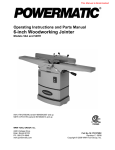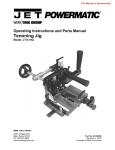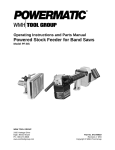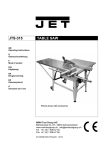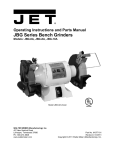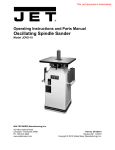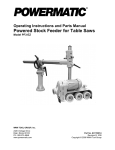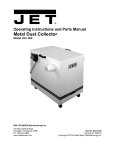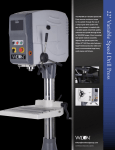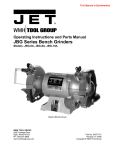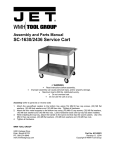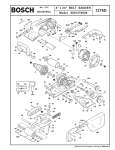Download Wilton 4210 User's Manual
Transcript
Operating Instructions — Parts Manual Wilton Belt and Disc Sanding Machine Model: 4210 WHM TOOL GROUP 2420 Vantage Drive Elgin, Illinois 60123 Ph.: 800-274-6848 www.wmhtoolgroup.com Part No. 5511717 Revision A8 02/05 Copyright © WMH Tool Group This manual has been prepared for owners of Wilton Model 4210 Belt and Disc Sanding Machine. Its purpose is to promote safety through the use of accepted operating and maintenance procedures. To obtain maximum life and efficiency from your Belt and Disc Sander and to aid in using it safely, please read this manual thoroughly and follow the instructions carefully. Warranty WMH Tool Group warrants every product it sells. If one of our tools needs service or repair, one of our Authorized Repair Stations located throughout the United States can give you quick service. In most cases, any one of these WMH Tool Group Repair Stations can authorize warranty repair, assist you in obtaining parts, or perform routine maintenance and major repair on your JET, Wilton, Powermatic, or Performax tools. For the name of an Authorized Repair Station in your area, please call 1-800-274-6848, or visit www.wmhtoolgroup.com More Information WMH Tool Group is consistently adding new products to the line. For complete, up-to-date product information, check with your local WMH Tool Group distributor, or visit www.wmhtoolgroup.com WMH Tool Group Industrial Metalworking Warranty WMH Tool Group makes every effort to assure that its products meet high quality and durability standards and warrants to the original retail consumer/purchaser of our products that each product be free from defects in materials and workmanship as follows: TWO (2) YEAR LIMITED WARRANTY* ON ANY MECHANICAL COMPONENT, ONE (1) YEAR LIMITED WARRANTY ON ANY ELECTRICAL COMPONENT. WMH This Warranty does not apply to defects due directly or indirectly to misuse, abuse, negligence or accidents, normal wear-andtear, repair or alterations outside our facilities, or to a lack of maintenance. WMH TOOL GROUP LIMITS ALL IMPLIED WARRANTIES TO THE PERIOD SPECIFIED ABOVE, FROM THE DATE THE PRODUCT WAS PURCHASED AT RETAIL. EXCEPT AS STATED HEREIN, ANY IMPLIED WARRANTIES OR MERCHANTIBILITY AND FITNESS ARE EXCLUDED. SOME STATES DO NOT ALLOW LIMITATIONS ON HOW LONG THE IMPLIED WARRANTY LASTS, SO THE ABOVE LIMITATION MAY NOT APPLY TO YOU. WMH TOOL GROUP SHALL IN NO EVENT BE LIABLE FOR DEATH, INJURIES TO PERSONS OR PROPERTY, OR FOR INCIDENTAL, CONTINGENT, SPECIAL, OR CONSEQUENTIAL DAMAGES ARISING FROM THE USE OF OUR PRODUCTS. SOME STATES DO NOT ALLOW THE EXCLUSION OR LIMITATION OF INCIDENTAL OR CONSEQUENTIAL DAMAGES, SO THE ABOVE LIMITATION OR EXCLUSION MAY NOT APPLY TO YOU. To take advantage of this warranty, the product or part must be returned for examination, postage prepaid, to an Authorized Repair Station designated by our office. Proof of purchase date and an explanation of the complaint must accompany the merchandise. If our inspection discloses a defect, we will either repair or replace the product, or refund the purchase price if we cannot readily and quickly provide a repair or replacement, if you are willing to accept a refund. We will return repaired product or replacement at WMH Tool Group’s expense, but if it is determined there is no defect, or that the defect resulted from causes not within the scope of WMH Tool Group’s warranty, then the user must bear the cost of storing and returning the product. This warranty gives you specific legal rights; you may also have other rights, which vary from state to state. WMH Tool Group sells through distributors only. WMH Tool Group reserves the right to effect at any time, without prior notice, those alterations to parts, fittings, and accessory equipment, which they may deem necessary for any reason whatsoever. ∗ WMH Tool Group Industrial Metalworking’s 2 year limited warranty is based on one 8-hour work shift or 2080 hours per year. The warranty period is good for 2 years of a total of 4160 hours whichever comes first. Table of Contents Cover Page ........................................................................................................................... 1 General Specifications .......................................................................................................... 4 Operating Precautions .......................................................................................................... 5 Introduction ........................................................................................................................... 7 Operating Instructions ........................................................................................................... 9 Maintenance ........................................................................................................................11 Wiring Diagram ................................................................................................................... 14 Troubleshooting .................................................................................................................. 16 Replacement Parts ............................................................................................................. 17 Wiring Diagram ................................................................................................................... 21 3 General Specifications The Wilton Model 4210 Belt and Disc Sanding Machine is ideal for all shops. This versatile machine can be used to grind, sand, finish, and contour all types of parts including metal, wood, plastic, and composite materials. Because of these capabilities, the Wilton sander eliminates the need for multiple machines to perform the same tasks. Specifications 4 Wilton Belt/Disc Sander, Model 4210 Belt Size 6" x 48" Disc Size 10" Motor Horsepower Voltage 1 HP 115/230 Vac (pre-wired for 115 Vac) Switch Removable Safety Key Platen Cast Iron Tables Cast Iron (2) Belt Speed 1650 SFPM Disc Speed 2100 RPM Dust Collection Shrouds Two (standard) Weight 120 lbs. General Machinery Cautions - Misuse of this machine can cause serious injury. - For safety, machine must be set up, used and serviced properly. - Read, understand and follow instructions in the operator’s and parts manual which was shipped with your machine. When setting up machine: - Always avoid using machine in damp or poorly lighted work areas. - Always be sure machine is securely anchored to the floor. - Always keep machine guards in place. - Always put start switch in “OFF” position before plugging in machine. When using machine: - Never operate with machine guards missing. - Always wear safety glasses with side shields (See ANSI Z87.1) - Never wear loose clothing or jewelry. - Never overreach — you may slip and fall into the machine. - Never leave machine running while you are away from it. - Always shut off the machine when not in use. When servicing machine: - Always unplug machine from electrical power while servicing. - Always follow instructions in operators and parts manual when changing accessory tools or parts. - Never modify the machine without consulting Wilton Corporation. You — the stationary power tool user — hold the key to safety. Read and follow these simple rules for best results and full benefits from your machine. Used properly, Wilton’s machinery is among the best in design and safety. However, any machine used improperly can be rendered inefficient and unsafe. It is absolutely mandatory that those who use our products be properly trained in how to use them correctly. They should read and understand the Operators and Parts Manual as well as all labels affixed to the machine. Failure in following all of these warnings can cause serious injuries. Machinery general safety warnings 1. Always wear protective eye wear when operating machinery. Eye wear shall be impact resistant, protective safety glasses with side shields which comply with ANSI Z87.1 specifications. Use of eye wear which does not comply with ANSI Z87.1 specifications could result in severe injury from breakage of eye protection. 2. Wear proper apparel; no loose clothing or jewelry which can get caught in moving parts. Rubber soled footwear is recommended for best footing. 3. Do not overreach. Failure to maintain proper working position can cause you to fall into the machine or cause your clothing to get caught — pulling you into the machine. 4. Keep guards in place and in proper working order. Do not operate the machine with guards removed. 5. Avoid dangerous working environments. Do not use stationary machine tools in wet or damp locations. Keep work areas clean and well lit. 6. Avoid accidental starts by being sure the start switch is “OFF” before plugging in the machine. 7. Never leave the machine running while unattended. 8. Disconnect electrical power before servicing. Whenever changing accessories or general maintenance is done on the machine, electrical power to the machine must be disconnected before work is done. 9. Maintain all machine tools with care. Follow all maintenance instructions for lubricating and the changing of accessories. No attempt shall be made to modify or have makeshift repairs done to the machine. This not only voids the warranty but also renders the machine unsafe. 10. Machinery must be anchored to the floor. 11. Secure work. Use clamps or a vise to hold work, when practical. It is safer than using your hands and it frees both hands to operate the machine. 12. Never brush away chips while the machine is in operation. 13. Keep work area clean. Cluttered areas invite accidents. 14. Remove adjusting keys and wrenches before turning machine on. 15. Use the right tool. Don’t force a tool or attachment to do a job it was not designed for. 16. Use only recommended accessories and follow manufacturers instructions pertaining to them. 17. Keep hands in sight and clear of all moving parts and cutting surfaces. 18. All visitors should be kept at a safe distance from the work area. Make workshop completely safe by using padlocks, master switches, or by removing starter keys. 19. Know the tool you are using — its application, limitations, and potential hazards. 5 General Electrical Cautions Wire sizes This machine should be grounded in accordance with the National Electrical Code and local codes and ordinances. This work should be done by a qualified electrician. The machine should be grounded to protect the user from electrical shock. Caution: for circuits which are far away from the electrical service box, the wire size must be increased in order to deliver ample voltage to the motor. To minimize power losses and to prevent motor overheating and burnout, the use of wire sizes for branch circuits or electrical extension cords according to the following table is recommended: Conductor length 0-50 feet 50-100 feet Over 100 feet AWG (American wire gauge) number 240 volt lines 120 volt lines No. 14 No. 14 No. 12 No. 14 No. 8 No. 12 Safety Requirements for Abrasive Sanding Machines 6 Abrasive sanding can be hazardous to operators and bystanders. Sanding sparks, chips and dust particles thrown off by the sanding disc can cause serious injury by contact or inhalation. To avoid injuries you must comply with the following safety requirements: 1. Always wear protective eyewear when operating machinery. Eye wear shall be impact resistant, protective safety glasses with side shields which comply with ANSI Z87.1. Use of eye wear which does not comply with ANSI Z87.1 specifications could result in severe injury from breakage of eye protection. See Figure A, below. 2. Wear leather safety gloves, arm guards, leather aprons and safety shoes. 3. A dust collection system is recommended, Operator shall also wear a dust mask at all times. See Figure B, below. 4. Additional precautions may be necessary for sanding materials which are flammable or have other hazardous properties. You should always consult the manufacturer of such materials for instructions on sanding and handling. 5. Do not force or jamb the workpiece into the sanding disc. 6. Before sanding, always allow the motor to come up to operating speed, then check the sanding disc Figure A Figure B for wobble, runout, or any unbalanced condition. If the disc is not operating accurately and smoothly, immediately stop the motor and make repairs before attempting any sanding operations. 7. Abrasive discs must be stored in a controlled environment area. Relative humidity should be 35% to 50% and the temperature should be between 60 and 80 degrees Farenheit. Failure to do so could cause premature disc failure. 8. Examine the face of the sanding disc carefully. Excessive sanding which wears down to the backing material can tearing of the disc. Never use a disc which shows backing, nicks or cuts on the surface or edge or damage due to creasing or poor handling. 9. When installing a new disc, be certain the disc is accurately centered on the drive wheel. Failure to do so could cause a serious unbalanced condition. 10. Always present the workpiece to the wheel while resting the workpiece firmly on the table. Failure to do so could result in damage to the workpiece or throwing of the workpiece off the wheel. 11. Safety shoes which comply with ANSI Z41.1 shall be worn. See Figure C. 12. Personal hearing protection such as ear plugs or ear muffs shall be used to protect against the effect of noise exposure. See Figure D. Figure C Figure D Introduction This manual includes operating and maintenance instructions for the Wilton Model 4210 Belt and Disc Sander. This manual also includes parts listings and illustrations of replaceable parts. Sanding Belt Belt Guard Platen Housing Belt and Disc Sander Features Figures 1 and 2 depict the main features of the Wilton Model 4210 Belt and Disc Sander. (Specifications for the sanding machine are provided on page 3.) Belt Sander Work Table Debris Duct On/Off Switch Machine Base Tracking Adjustment Belt Tensioning Lever Stand Belt Work Table Clamping Knob Sanding Disk Disc Debris Duct Power Cord Miter Gauge Figure 2: Belt and Disc Sander Features (Left Side View) The sander has both a sanding belt and a sanding disc for use on a variety of work pieces and materials. Disc Work Table Clamping Knob Figure 1: Belt and Disc Sander Features (Right Side View) The platen housing for the belt sander can be positioned vertically or horizontally. When in the vertical position, the drum at the upper end of the platen housing can be used for contouring. A tracking adjustment mechanism for the sanding belt is provided at the upper end of the platen housing. The platen housing has a lever that is used to apply tension to the sanding belt. The sanding belt is easily replaced by releasing the tension lever, removing a sanding shroud and dust collection duct at the bottom of the platen housing, and slipping the belt from the belt sander drums. Installation is the reverse of the removal steps. 7 The disc sander consists of an aluminum disc onto which is installed an adhesive-backed sanding and other abrasive discs. The disc is contained within a ducted shroud. The sanding disc can be replaced by removing the table and a cover over the lower portion of the disc. If desired, the aluminum disc can be removed from its drive shaft to ease replacement of the sanding disc. The drive motor for the belt and disc sander is attached to the underside of the machine base. An ON/OFF switch is mounted on the machine base on the side opposite the disc sander. Electrical wiring for the motor enters the machine base below the ON/ OFF switch and is routed to the switch and motor inside the machine base. The belt and disc sander is driven by V-belts connected to the drive motor. A pulley on the motor shaft drives a V-belt that drives a dual-groove pulley on an idler shaft. A second V-belt is installed in the second groove of the dual-groove pulley and connects to a pulley on belt sander drive shaft. The aluminum sanding disc is driven off the end of the idler shaft. A shaft connected to the second Vbelt pulley drives the belt sander drive drum. The belt and disc sander is mounted on a stand that can be secured to the floor to stabilize the machine. The stand has a door for access to the fasteners for the machine base. 8 Installation and Setup Mounting It is recommended that the belt and disc sander be secured to the floor for safe operation. The machine stand has mounting holes in a flange on the inside of stand enclosure. The stand can be secured to the floor using these mounting holes. Electrical Connection Refer to the Wiring Data section for wiring information. Electrical power should be connected by a qualified electrician. Observe local electrical codes when connecting and grounding the machine. Operation This section defines the controls and other features with which the operator should be familiar. Refer to Figures 3 and 4 for some typical sander operations. Figure 5. ON/OFF Switch Miter Gauge A miter gauge is provided with the machine and can be used on either the belt sander of disc sander work tables. The angle of the miter gauge can be adjusted up to 45 degrees to accommodate angular work piece surfaces. Adjustments Adjusting Belt Tracking Figure 3. Contouring with Belt Sander The tracking of the sanding belt may require adjustment after changing the belt. The belt housing has a tracking adjustment mechanism (Figure 6) that is used to adjust tracking. 1. Start the machine. 2. Check tracking of the sanding belt. The belt should track at the center of the drums. 3. Adjust belt tracking by turning the adjustment knob. Turn the knob as needed to correct the tracking of the belt. 9 Belt should track at center of drums; no side-to-side movement. Belt Tracking Adjustment Knob Figure 4. Sanding using Disc Sander Controls Belt Tensioning Lever The ON/OFF switch is located on the side of the machine base (refer to Figure 5). Figure 6. Adjusting Belt Tracking Adjusting Platen Housing Position The sanding belt can be operated with the platen housing horizontal, vertical, or at any angle in between. Change position of the platen housing as follows: Disc Table 1. To change the disc table angle, loosen the knob on the left side of the table (refer to Figure 8). 2. Move the table to the desired angle. 3. Tighten the knob to secure the table. WARNING: DISCONNECT ELECTRICAL POWER TO THE MACHINE BEFORE PERFORMING ANY MAINTENANCE. 1. Disconnect electrical power. 2. Remove four screws (52) and pulley cover (12). 3. Using an open end wrench, loosen two hex screws (13) (refer to Figure 7). 4. Move the platen housing to the desired position. When the platen housing is to be placed in the horizontal position, lower the platen housing onto stop screw (28) on the machine base. 5. If the stop requires adjustment, loosen jam nut (29), adjust stop screw (28) to desired position, and tighten nut (29). 6. Tighten two hex screws (13). 7. Install pulley cover (12) and secure with four screws (52). 8. Start the machine to check operation. Belt Table Clamping Knob Belt Table Angle Scale (left underside of table) Disc Table Angle Scale Table Clamping Knob Figure 8. Adjusting Sander Table Angle 10 Belt Table Clamping Screws Platen Housing Figure 7. Platen Housing Clamping Screws Adjusting the Sander Tables The belt and disc sander tables can be adjusted from 0 to 45 degrees to accommodate the work piece. 1. To change the belt table angle, loosen the knob on the right side of the platen housing (refer to Figure 8). 2. Move the table to the desired angle. 3. Tighten the knob to secure the table. Maintenance This section provides procedures required to maintain the belt/disc sander. The numbers in parentheses throughout the manual correspond with reference numbers for parts shown in the exploded views in the Replacement Parts section. Lubrication The bearings used in the sanding machine are sealed, pre-lubricated bearing. The bearings do not require periodic lubrication. Cleaning Periodically use a vacuum cleaner to remove sanding debris from the machine. In hard to reach areas, brush the debris loose while vacuuming. Replacing the Sanding Belt WARNING: DISCONNECT ELECTRICAL POWER TO THE MACHINE BEFORE PERFORMING ANY MAINTENANCE. 1. Disconnect electrical power. 2. Position sanding belt platen (4) in the vertical position. Remove eight screws (97) and guard (96). 3. Remove screw (76) and guard (75). 4. Move tensioning lever (50) downward to slacken sanding belt (79). Refer to Figure 9. Slip sanding belt off drums (5) and (39). Figure 9. Replacing Sanding Belt 1. Install replacement sanding belt on drums. Position edges of sanding belt evenly on the drums. 2. Lift tensioning lever to tighten sanding belt on drums. 3. Install guard (75) and secure with screw (76). 4. Install guard (96) and secure with eight screws (97). 5. Connect electrical power and operate machine to check operation. 6. If belt does not track properly, adjust tracking (refer to Adjusting Belt Tracking). Replacing the Sanding Disc WARNING: DISCONNECT ELECTRICAL POWER TO THE MACHINE BEFORE PERFORMING ANY MAINTENANCE. 1. Disconnect electrical power. 2. Loosen screw (65). Remove disc table (60). 3. Remove four screws (56) and plate (55) from disc shroud (53). 4. Insert a long T-handle Allen wrench through the side opening in shroud (53) and into set screw (57). Loosen disc set screw (57) and remove disc (58). WARNING: USE CARE WHEN USING KNIFE TO SEPARATE SANDING DISC (59) FROM DISC (58). INJURY FROM THE KNIFE MAY OCCUR IF THE KNIFE SLIP OR IF SANDING DISC SHOULD SUDDENLY COME FREE. 5. Using a knife, slowly work the tip of the knife blade under sanding disc (59). Slowly work the tip around the circumference of disc (58). Continue to work around the circumference until sanding disc can be separated by hand from disc (58). 6. Remove paper backing from replacement sanding disc (59). Place sanding disc (59) on disc (58). Make sure the sanding disc is place evenly at the outside diameter of disc (58). 7. Press on the sanding disc to remove any entrapped air and to make sure the sanding disc is adhering to disc (58). 8. Install disc (58) onto shaft (16). Position the disc on the shaft to provide clearance between plate (55) and sanding disc. Tighten set screw (57). NOTE: There is a close fit between the edge of disc (58) and disc shroud. To ease installation and positioning of the disc, use an L-shaped tool (such as an Allen wrench) under outer edge of the disc to support and position the disc while tightening set screw. 11 9. Install plate (55) and secure with four screws (56). Check for clearance between plate (55) and the sanding disc. 10. Install table (60) onto rod (74). Position table so it is level and tighten screw (65) against rod (74). 11. Connect electrical power and operate machine to check operation. Replacing the V-Belts WARNING: DISCONNECT ELECTRICAL POWER TO THE MACHINE BEFORE PERFORMING ANY MAINTENANCE. 1. 2. 3. 4. 5. 6. 7. 8. 9. 10. 11. Disconnect electrical power. Remove sanding belt table. Remove sanding disc table. Remove sanding disc and shroud. Remove pulley cover. Loosen set screw in pulley. With second person holding belt housing, alternately loosen and remove two screws. Remove V-belt from pulley (11). Remove pulley from shaft while separating assembled belt housing from the machine base. Remove key from sanding belt drum shaft. Loosen set screw in pulley (20). Remove pulley. While removing pulley, slip Vbelts from pulley. Remove four screws from base. With assistance of the second person, lift base from stand. NOTE: Place base on bench. As an alternative, the stand may be used to support the base while removing drive motor screws. 12 12. Place base on bench with underside of the base facing up. 13. Remove two hex head screws, two nuts, and two washers from the motor base on the shaft side of motor. 14. Loosen (but do not remove) two hex bolts, two nuts, and two washers on the side of motor base opposite the motor shaft. 15. Tip motor enough to provide clearance between end of shaft and wall of base. Remove motor drive belt. 16. With base still on the bench, slip V-belt (15) over end of idler shaft. NOTE: Install V-belt for sanding belt first, followed by the motor V-belt. 17. Install replacement V-belt over end of motor shaft. 18. Install two hex bolts, two nuts, and two washers in the motor base on the shaft side of motor. Tighten all four hex nuts and hex head screws. 19. Install key in idler shaft with keyway facing up. Install pulley (20) on idler shaft. 20. Install motor V-belt (18) in outermost groove of pulley (20) and on pulley (18) on motor shaft. 21. Position motor belt (18) on idler shaft so it is parallel with the inner wall of the base. Tighten set screw in pulley (20). 22. Place assembled base on stand. Secure with four screws, washers, nuts. NOTE: Because of the weight of the belt housing, a second person should hold the belt housing in position while installing pulley (10). 23. Hold belt housing in position in bracket (3). Start two screws (13) in threaded holes in platen. Install key (8) in shaft. NOTE: Because of the length of screws (13), the screws will have to be installed alternately. As the screws are installed, there will be enough clearance to slide the belt drum drive pulley a little at a time onto shaft (8). 24. Alternately install two screws (13). As the screws are tightened, slide pulley (10) onto the idler shaft as allowed by the protrusion of screw heads. Make sure V-belt remains on pulleys (11 and 20). 25. When screws (13) are fully installed, align pulley (20) with pulley (11). Tighten set screw (10). 26. Install shroud (53) on base and secure with four screws and washers. 27. Install pulley cover (12) and secure with two screws. 28. Install disc (58) onto shaft (16) and over key. Position the disc on the shaft to provide clearance between plate (55) and the sanding disc. Using long T-handle Allen wrench, tighten set screw (57). NOTE: There is a close fit between the edge of disc (58) and the disc shroud. To ease installation and positioning of the disc, use an L-shaped tool (such as an Allen wrench) under the outer edge of the disc to support and position the disc while tightening the set screw. 29. Install plate (55) and secure with four screws (56). Check for clearance between plate (55) and the sanding disc. 30. Install table (60) onto rod (74). Position table so it is level and tighten screw (65) against rod (74). 31. Install assembled table (88). 32. Connect electrical power and operate machine to check operation. Replacement of Motor WARNING: DISCONNECT ELECTRICAL POWER TO THE MACHINE BEFORE PERFORMING ANY MAINTENANCE. 1. Disconnect electrical power. 2. Remove four screws from base. With assistance of the second person, lift base from stand. NOTE: Place base on bench. As an alternative, the stand may be used to support the base while removing drive motor screws. 3. Place base on bench with underside of the base facing up. 4. Remove four hex head screws, nuts, and washers from the motor base. 5. Remove motor V-belt from motor pulley. 6. Remove motor from base. 7. Loosen set screw in pulley (18). Remove pulley. 8. Align set screw in pulley with flat on motor shaft and install pulley. Do not tighten set screw. 9. Install replacement V-belt over end of motor shaft and install motor in base . Secure with four screws, washers and nuts. 10. Install and tighten four hex bolts, nuts, and washers in the motor base. 11. Position pulley (18) on motor shaft so the V-belt is parallel with the inner wall of the base. Tighten set screw in pulley (20) against flat on motor shaft. 12. Place assembled base on stand. Secure with four screws, washers, nuts. 13. Connect electrical power and operate machine to check operation. 13 Wiring Data Single phase electrical hook-up When connecting your machine to single phase power you may be connecting to either 115 or 230 volts, depending upon the motor type provided. Local codes may, or may not, permit the use of a plug type of connection for your machine. Where a plug connection is permitted, the following installation practices must be followed: 1. The plug used must be a grounding type of plug. On a 115 volt single phase connection, the plug must be a three-prong plug with two flat, parallel blades for the power wires and a single rounded or U-shaped prong for the ground connection. On 230 volt single phase connections, the lug must be a three prong plug with two flat blades in tandem to carry the current, and a third round or U-shaped prong for the ground connection. 2. The service branch to which the plug is connected must be a branch with a separate ground wire so the grounding prong of the plug can be connected to ground effectively. Note: Local electrical codes in many jurisdictions do not allow the use of plug type connections for single phase power when the machine is used in a commercial or industrial establishment. In these cases you must connect your machine to the service branch using a hard-wired junction box connection. All Wilton sanders are shipped with the power cable terminating without a plug on the assumption the machine will be hard-wired to its service branch. Circuit protection Where the service branch is protected with a fuse or circuit breaker which is too high a value to offer protection to the motor supplied, a fuse or circuit breaker box should be used at the point where the machine connection is made and the time delay fuse or circuit breaker should be a value just slightly higher than the maximum load current draw as specified on the motor plate on the motor. Correcting motor rotation in single phase motors Wilton provides single phase motors in both 115 volt and 230 volt configuration. Several motor manufactures may be used by Wilton for motors of this type. These motors may, or may not, rotate in the correct direction -- counter-clockwise -- when connected to your single phase power source. If, after connection, the motor runs in the correct counter-clockwise direction, the power connection is successful. 14 Figure 10: Pictoral diagram for single phase motor, 115 volts w/plug. CAUTION: IF THE MOTOR RUNS CLOCKWISE WHEN CONNECTED TO YOUR SINGLE PHASE POWER SOURCE, YOU MUST DISCONNECT THE POWER SOURCE, OPEN THE JUNCTION BOX AND FIND THE CORRECT WIRING CONNECTIONS FOR THE MOTOR, OR LOCATE THE WIRING CONNECTIONS REQUIRED ON THE MOTOR PLATE ON THE OUTSIDE OF THE MOTOR. Different manufacturers provide different wiring configurations for correcting the rotation of the motor armature. Therefore, no wiring diagrams for these motors are provided in this manual. Always consult the motor plate and/or the wiring diagram inside the junction box if rotation direction is not correct. Figure 11: Pictoral diagram for 3-phase motor. Connecting Power for 3-phase Motors 1. Be certain the power to the branch you are connecting is off, and locked out, so power cannot be reestablished, accidentally. 2. Connect the ground wires. Thse wires will be either green, or green with a white trace. 3. Connect the remaining three cable wires to the three power wires in the service branch. 4. Reestablish power to the branch. 5. Turn the machine on. The motor should be turning counter-clockwise, the belt sander should be moving downward, and the disc sander should 6. 7. 8. 9. be turning clockwise. If this is the case, the machine can be considered wired correctly. If the motor is not turning in the correct direction, take the following corrective action: Disconnect power in the branch again and be certain it cannot be accidentally turned on while you correct the wiring. Reverse ANY TWO of the power wires to the machine. Reestablish power in the service branch to the machine. Turn on the machine again. The motor should now be turning in the correct direction. Figure 12: Schematic diagram for single phase motor with 3-wire cable. Note: this schematic provided for use with older sanders, only. All machines are now shipped with a 4-wire cable whether single phase or 3-phase. Figure 13: Schematic diagram for single phase motor with 4-wire cable. 15 Figure 14: Schematic diagram for 3-phase motor. Troubleshooting Fault Probable Cause Remedy Machine does not start. 1. Blown fuse or tripped circuit breaker. 1. Determine reason for blown fuse/tripped breaker (such as a short circuit or motor overload). Correct reason for fault. Replace fuse/reset breaker. 2. Replace motor. 3. Connect to power source. 2. Motor failure. 3. Not connected to power source. 4.Motor not wired for correct voltage. 5. Motor not connected to correct voltage source. Sanding belt does not trackcorrectly. 16 1. Sanding belt stretched unevenly. 2. V-belt worn. 3. Pulley worn. 4. Correct motor wiring. 5. Connect to proper voltage source. 1. Replace sanding belt. 2. Replace V-belt. 3. Replace pulley. Abrasive disc separates from disc. 1. Improperly bonded. 1. Clean residual adhesive from disc. Reapply adhesive-backed disc to clean disc. Sanding belt slips or stalls when pressure is applied. 1. Abrasive belt tension inadequate. 2. Excessive pressure being applied to platen housing. 3. Motor belt loose. 1. Tighten sanding belt. 2. Reduce pressure on sanding belt (and platen housing). 3. Tighten motor belt. Disc stalls when pressure is applied. 1. Motor V-belt loose. 1. Tighten motor V-belt. Frequent replacement of sanding belt. 1. Too much pressure being applied to work piece. 2. Full width of belt not being used. 1. Reduce pressure on work piece. 2. Stroke across sanding belt using full width of belt surface. Replacement Parts This section provides exploded view illustrations that show the replacement parts for the Wilton Model 4210 Belt/ Disc Sander. Also provided are parts listings that provide part number and description. The item numbers shown on the illustration relate the item number in the facing parts listing. Order replacement parts from: WHM TOOL GROUP 2420 Vantage Drive Elgin, Illinois 60123 Ph.: 800-274-6848 www.wmhtoolgroup.com To order parts or reach our service department, call 1-800-274-6848 between 7:30am and 5:30pm (CST), Monday through Friday. Having the Model Number and Serial Number of your machine available when you call will allow us to serve you quickly and accurately. . 17 Assembled View and Parts Listing of Stand – Model 4210 Belt and Disc Sander 3 2 1 18 Ref. No. Part Number Description Qty. 1 2 3 5513476 5513477 5515307 Panel, Access Knob Stand, Complete 1 2 1 Exploded View – Wilton Model 4210 Belt & Disc Sander 19 Parts Listing – Wilton Model 4210 Belt & Disc Sander 20 Ref. No. 2 3 4 5 6 7 8 8A 9 10 11 12 13 14 15 16 17 18 20 21 22 23 24 25 26 27 28 29 30 31 32 33 34 35 36 37 38 39 40 41 42 43 Part Number 5513011 5513012 5513013 5513014 5513015 5513016 5513017 5513028 5513018 5513019 5513020 5513021 5513022 5513023 5513024 5513025 5513026 5513027 5513029 5513030 5513031 5513032 5513033 5512767 5513035 5513036 5513037 5513038 5513039 5513040 5513041 5513042 5513043 5513044 5513045 5513046 5513047 5513048 5513049 5513050 5513051 5513052 44 45 46 47 48 49 50 51 52 53 54 55 56 5513054 5513055 5513056 5513057 5513058 5513059 5513060 5513061 5513062 5513063 5513064 5513065 5513066 Description Base Bracket Platen Drum, Drive Shaft, Drum Drive Bearing (6203ZZ) Key Key Ring, Retaining (S-17) Screw, Set (1/4 X 3/8) Pulley Cover, Pulley Screw (5/16 X 1-1/2) Washer, Plain (5/16) V-Belt (A-18) Shaft, Drive Pulley Bracket Pulley, Motor Pulley, Idler V-Belt (A-25) Screw (5/16 X 3/4) Washer, Flat (5/16) Nut, Hex (5/16) Motor, 1-HP Screw, Hex (3/8 X 1) Washer, Flat (3/8) Screw (3/8 X 1-1/2) Nut, Jam Bracket, Mounting Screw (5/16 X 1) Washer (1/4) Screw, Hex (1/4 X 3/4) Spring (1/4) Shaft Shaft, Driven Drum Ring, Retaining (S-15) Bearing (6202ZZ) Drum, Driven Nut (1/4) Spring Washer, Flat Rod, Threaded, Belt Tracking Adjustment Support, Driven Drum Screw (5/16 X 1/2) Bracket Bar Screw (3/16 X 1/2) Washer (3/16) Lever, Belt Tension Screw (5/16 X 1-1/4) Screw (3/16 X 3/8) Guard, Disk Washer, Lock (3/16) Plate, Cover Screw (3/16 X ¼) Qty 1 1 1 1 1 2 1 1 2 1 1 1 4 4 1 1 1 1 1 1 4 8 4 1 3 3 1 1 1 1 6 2 1 1 1 2 2 1 1 1 1 1 1 1 1 1 6 2 1 1 2 1 4 1 5 Ref. No. 57 58 59 Part Number 5513067 5512765 5513071 5513073 5513075 60 5513077 61 5513078 62 5513079 63 5513080 64 5513081 65 5513082 66 5513083 67 5513084 68 5513085 69 5513086 70 5513087 71 5513088 72 5513089 73 5513090 73A 5513091 74 5513092 75 5513093 76 5513094 77 5513095 77A 5513096 78 5512766 79 5051841 Description Screw, Set (6 X 10 MM) Disk, Aluminum Garnet Disk 10": 80 Grit (Standard) Also available: 100 Grit 120 Grit Table, Side Support, Table Bracket, Table Support Pin, Spring Screw (1/4 X 3/8) Screw, Hex (5/16 X 1) Pin, Spring Bracket, Table Support Washer, Flat Pointer Knob Washer Rivet Scale Pointer Rod, Table Support Guard, Belt Screw (3/16 X 5/8) Cover, Sanding Belt* Screw, Cap* Switch Belt, Abrasive(6 x 48) 80 Grit (Standard) Also available: 100 Grit 150 Grit Washer Knob (1/4 X 1-1/2) Bracket, Table Screw (5/16 X 1-1/2) Pin (4 X 15) Table, Sanding Belt Wrench* Screw, Socket Head Washer, Flat Nut, Hex Screw, Hex Head Washer, Flat Nut, Hex Cover, Belt Screw, Socket Head Guard, Belt Screw Gauge, Miter Head, Complete 82 83 84 85 86 88 89 90 91 92 93 94 95 96 97 98 99 100 5512764 5513103 5513107 5513108 5512763 5513110 5513111 5513113 5513114 5513115 5513116 5513117 5513118 5513119 5513120 5513479 5513480 5514639 5514640 5517426 5515308 * Part not shown. Qty 1 1 1 1 1 1 1 1 1 4 1 1 1 2 1 1 1 3 1 1 1 1 1 1 8 1 1 1 1 1 1 1 3 1 1 1 2 2 2 2 2 2 1 8 1 4 1 1 Wiring Diagram 4210 ELECTRICAL SCHEMATIC - 115V SWITCH BLACK BLACK WHITE WHITE GREEN 300MFD 125 VAC YELLOW BLACK GREY RED GREEN GREEN BLACK WHITE GROUND 4210 ELECTRICAL SCHEMATIC - 230V SWITCH BLACK BLACK WHITE WHITE GREEN 21 300MFD 125 VAC BLACK GREY YELLOW RED GREEN GREEN BLACK WHITE GROUND Notes Notes WHM TOOL GROUP 2420 Vantage Drive Elgin, Illinois 60123 Ph.: 800-274-6848 www.wmhtoolgroup.com
























